Aloe Vera plants look great with their thick green leaves. But sometimes, you might notice that the leaves are drying. This will happen even with proper care because you are not giving attention to something unintentionally. Today, we will learn the reasons behind a drying aloe vera plant.
Generally, Aloe vera dries out due to a lack of water. Though they enjoy dry soil between watering, eventually, they will need water to stay hydrated. Aloe vera leaves can also dry out because of overcrowding in the pot, which results in a struggle for water and nutrients.
I will explain all the reasons behind drying Aloe Vera in this article. Along with that, I will also share some tips to keep the Aloe Vera plant healthy.
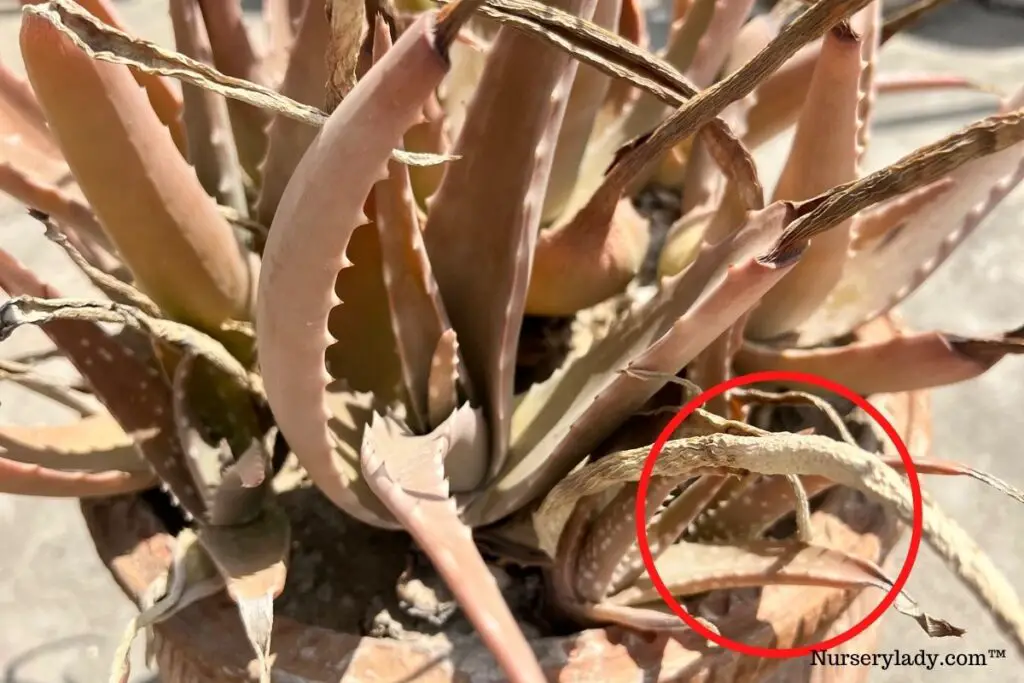
Why is my Aloe Vera plant drying?
There are several reasons behind the Aloe Vera plant drying out.
Below I have shared what I have observed:
- Direct sunlight
- Dormancy and heat harm
- Underwatering
- Faster evaporation
- Waterlogged conditions
- Freeze damage
- Overcrowding
- Pests
- Diseases
- Lack of light
Aloe Vera drying out is not generally the end of your plant’s life.
With quick identification and proper action, you can easily make the plant green, fresh, and healthy like before.
So, let’s understand the reasons without further delay.
Direct sunlight
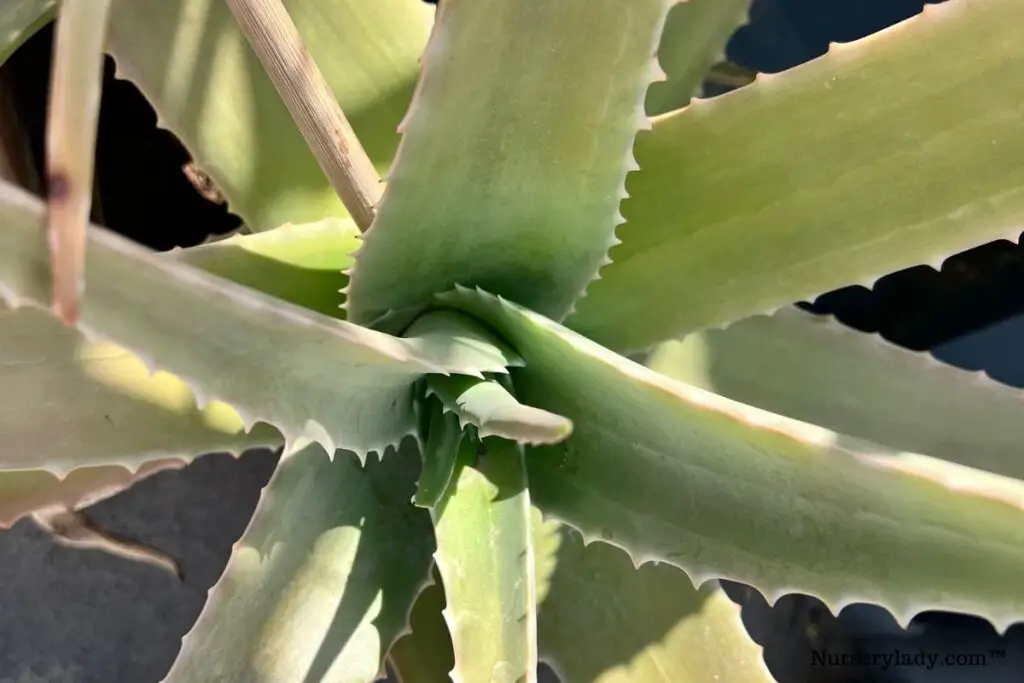
The soil dries out faster when the aloe vera stays under direct sunlight.
As a result, the plant runs out of moisture.
Direct sunlight will also burn the leaves.
Due to these two reasons, the leaves will begin to dry out.
How to reduce extreme sun exposure?
Indeed Aloe Veras need a proper amount of sunlight for enough growth, but too much exposure to sunlight can burn them and dry them out.
Fix shading nets to protect the Aloe Veras from harsh sunlight during the summer.
Water Aloe veras frequently as they dry out faster under direct sunlight.
Despite being a drought-lover, the plant prefers slightly moist soil.
It keeps them hydrated and prevents prolonged dryness.
If your plant is near a south or west-facing window indoors, shift them a few feet back or put on sheer curtains to filter the sun.
Also read: What Kind Of Light For Aloe Vera Plants? (Full sun, Shade, Or Partial Light?)
Heat stress and dormancy period
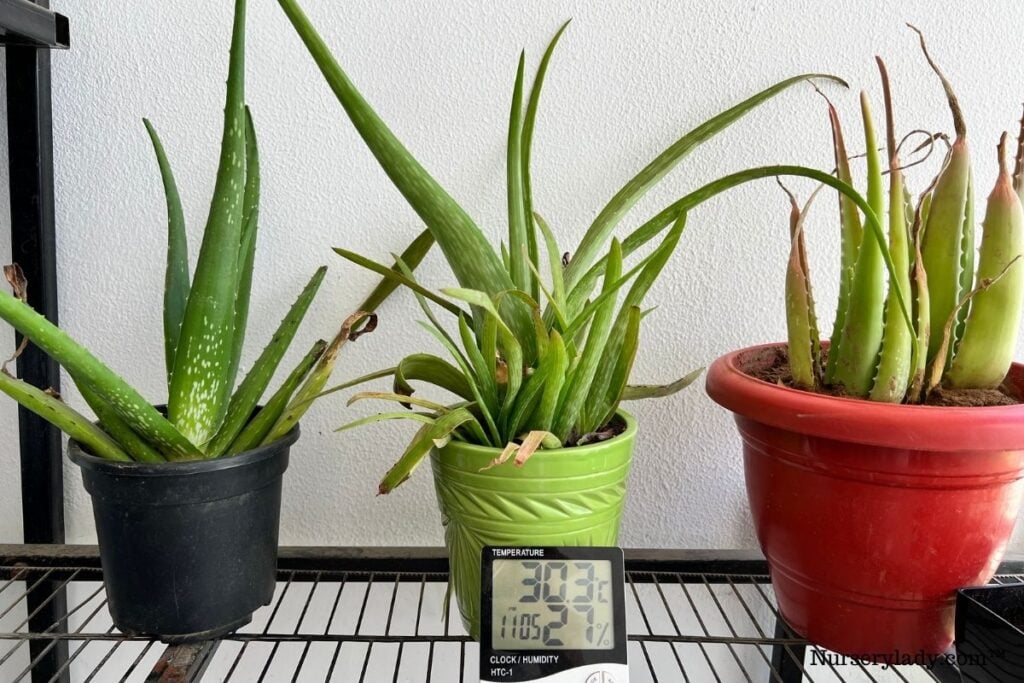
Aloe Veras are naturally adapted to endure heat as their native land is arid regions.
But, they have a built-in mechanism where they will go dormant if the heat is too much.
This happens when the temperature rises above 80-90°F.
During dormancy, the plant will get dehydrated.
The leaves will wrinkle, dry out and drop off the plant.
The plant will eventually stop its growth.
This response is normal due to a lack of water, heat, and high temperatures.
What should I do?
You have to reverse their surrounding growing conditions to save them from drying out.
- Shift them to a place where the heat intensity is quite less than outdoors.
- You can fix shading nets if they are under the direct sun. Some shade can decrease the heat level and give cool weather in the surrounding.
- If your plant is indoors, bring them away from sunny windows. Shift them to a cool room where the temperature stays within 55 to 75°F.
- Water the plant but not too much. Since it is their dormancy period, watering should be done carefully. The plant rests and uptakes water very slowly. Watering can keep them hydrated and keep the plant from drying out.
- Don’t flood the aloe will water. Otherwise, that too will dry out the leaves and lead to leaf drops.
Also read: Aloe Vera Temperature Tolerance: Ideal Temperature+Keeping Them Safe
Looking for gardening supplies? We have tested 100's of products before recommending them to you guys. Check out our best pick below:
| Image | Gardening Supplies | Best Price? |
|---|---|---|
 Top
Top Top
Top | Raised Garden Bed Kit | Check On Amazon |
 | XLUX Soil Moisture Meter, Plant Water Monitor, Soil Hygrometer Sensor for Gardening, Farming, Indoor and Outdoor Plants, No Batteries Required | No Results |
 Top
Top Top
Top | 82 Pcs Garden Tools Set and Extra Succulent Tools Set | Check On Amazon |
 | Joeys Garden Expandable Garden Hose with 8 Function Hose Nozzle, Lightweight Anti-Kink Flexible Garden Hoses, Extra Strength Fabric with Double Latex Core, (50 FT, Black) | No Results |
 Top
Top Top
Top | Dual Chamber Compost Tumbler | Check On Amazon |
 Top
Top Top
Top | Sunnyglade Plant Stakes | Check On Amazon |
 Top
Top Top
Top | Organic Cold Pressed Neem Seed Oil | Check On Amazon |
 Top
Top Top
Top | Mighty Mint Gallon :-Insect and Pest Control Peppermint Oil | Check On Amazon |
 Top
Top Top
Top | Scotts DiseaseEx Lawn Fungicide | Check On Amazon |
 Top
Top Top
Top | Jacks Classic 20-20-20 All Purpose Fertilizer | Check On Amazon |
 Top
Top Top
Top | 30,000 Seeds Pollinator Attracting Wildflower Mixture | Check On Amazon |
 Top
Top Top
Top | Survival Vegetable Seeds Garden Kit-Over 16,000 Seeds | Check On Amazon |
Underwatering
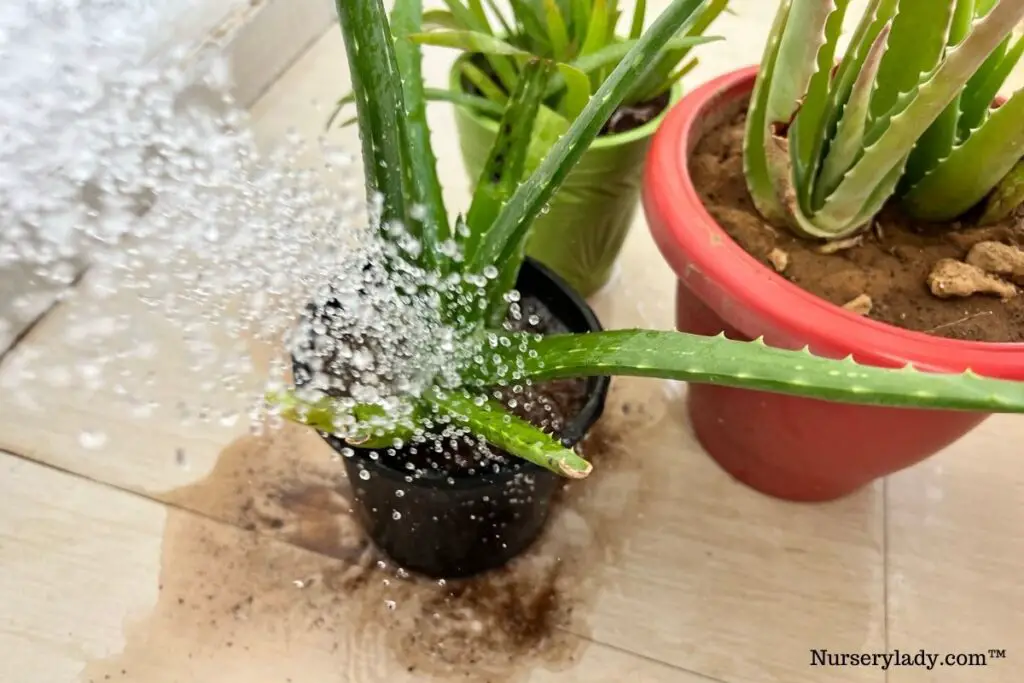
Watering them is very important since the Aloes enjoy staying under the direct sun with warm temperatures.
They will dry out frequently, and you have to check the soil’s condition now and then.
If you neglect to water just because they can tolerate it, it will only result in prolonged dryness.
Indeed Aloe Vera likes dry conditions, but eventually, they will need water to stay hydrated.
The leaves will become hard, wrinkled, and dry without enough water.
Eventually, they will start falling off the plant.
To identify underwatering, check the edges of the leaves.
The middle part of the leaf is hard, but the edges will become dry and crispy.
How to improve watering habits?
- Give your plant a good soak. But don’t pour too much water at once. That can lead to overwatering.
- You must water the plant every 2-3 weeks. It would be best if you watered them every 1-2 weeks during their growing season and hot weather.
- Before following the routine, don’t forget to check the moisture level. If the top 2-3 inches of the soil is dry, the plant is ready to take water.
Also read: How To Water Aloe Vera Plant? (How often, Summer, Winter)
Quick evaporation
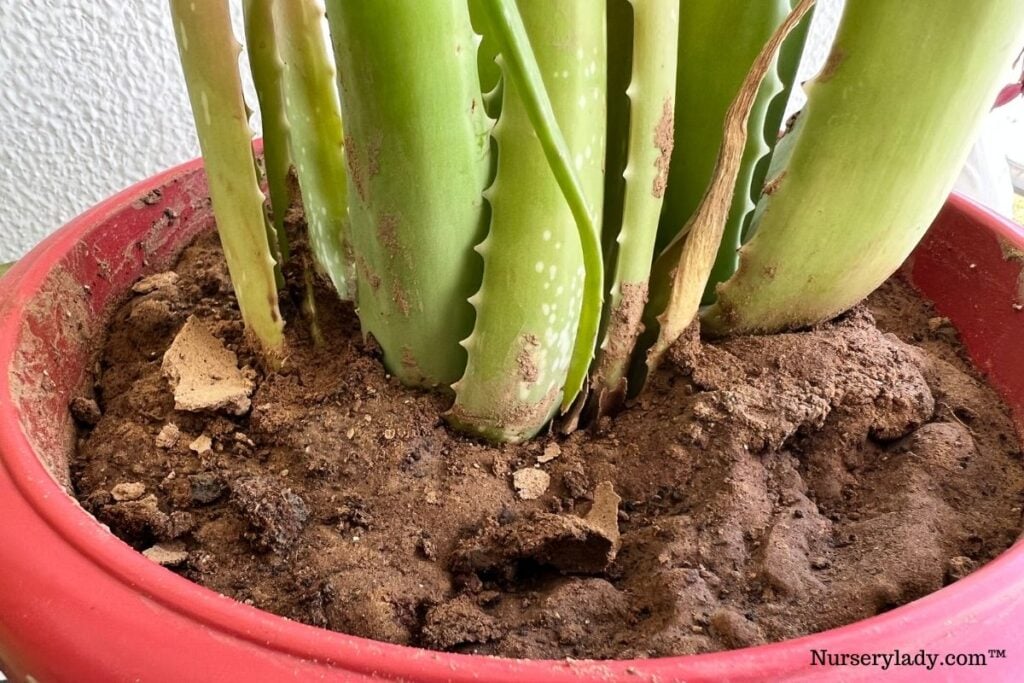
Evaporation from the plant’s tissues is called transpiration.
The water escapes from the stomatal pores of the leaf surface.
The Aloe Vera will dry out due to the fast evaporation rate.
Fast evaporation and transpiration occur due to a sudden reduction in humidity or excessive wind speed.
How to fix the problem?
- Keep them to a place with no speedy wind around.
- Low humidity is not a problem, but sudden change can affect the Aloes. Don’t change the position of your plant suddenly without determining the surrounding conditions of that particular location.
- Outdoors, the humidity problem will be less because it changes gradually. The plant will easily adjust to the new weather.
- Ensure that a single Aloe Vera plant is not standing in your garden. It will get all the wind from the surroundings and fast evaporation – plant Aloes with some companions.
- Besides, having tall trees around at an adequate distance can obstruct the winds from reaching the Aloes directly.
- Don’t suddenly shift them near air conditions or fans if your plant is indoors. This will give them fast wind, sudden low humidity, and cold drafts.
Waterlogged situation
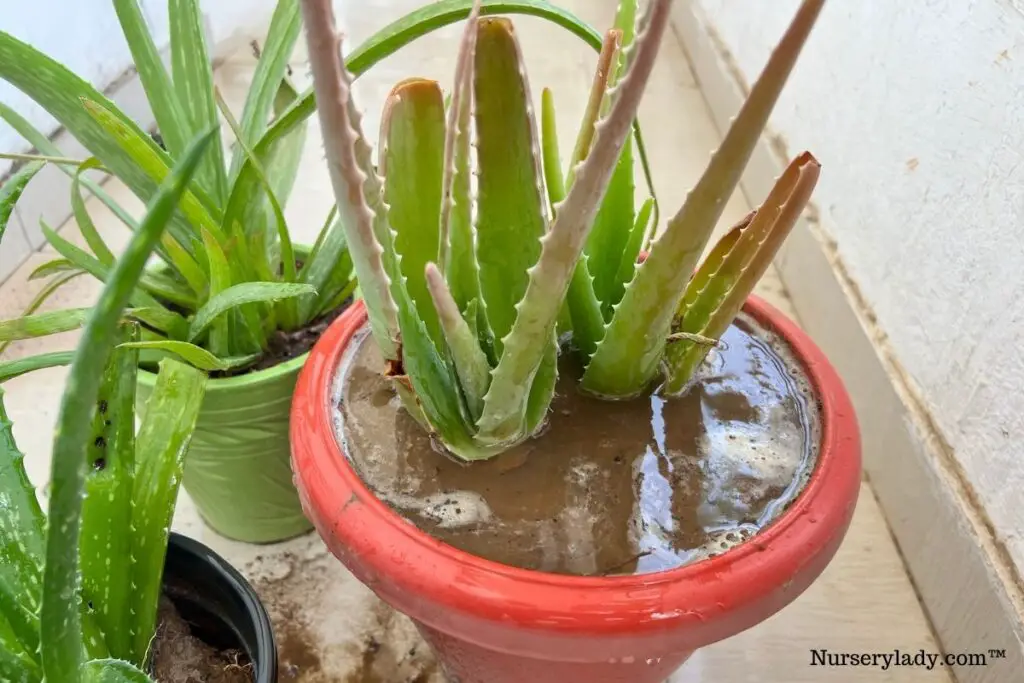
Soggy soil can dry out the plant, especially during the winter season.
You might be wondering how.
It’s because waterlogged conditions can only lead to damp and mushy leaves.
When the soil is waterlogged, the water stays stagnant and suffocates the roots.
As a result, the roots fail to pass water to the other parts, thus drying out the tips of the leaves.
It will also lead to cold damage and root rot.
How to treat the waterlogged Aloe Vera plant?
- Limit the watering during the winters as they grow slowly. The soil must stay almost dry.
- Always check the moisture level of the soil before watering.
- If you must follow a routine, water the Aloe Veras once in 2-3 weeks on normal days and once a month during winters.
- Allow the growing medium to dry out between each watering.
- Using well-drained soil and container with drainage holes can solve half of the problem.
Also read: What Type Of Soil For Aloe Vera Plant? (+Ideal Soil Mix)
Freeze damage
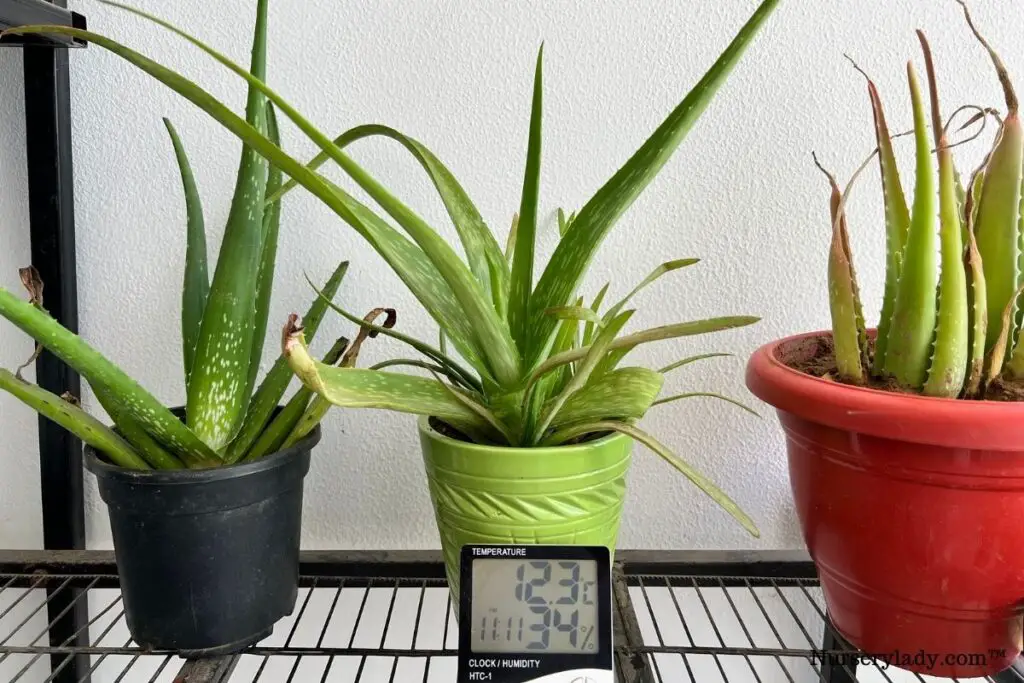
Aloe Veras will tolerate temperatures up to 55°F to 75°F.
They cannot tolerate cold temperatures, especially when it drops below 50°F.
If your Aloes are outside, you must take them indoors when the temperature drops.
If you don’t give your plant protection against cold, the leaves will have damp black marks and a withering look.
Since they store water in the leaves, it will freeze and crack, thus destroying the cells and tissues.
Over time, the leaves will become slimy, dry, and brittle.
If the plant stays like this for a long time, all the leaves will dry.
How to remedy freeze damage?
- Shift your plant to a warm area. Let the plant receive enough sunlight. This can reduce the temperature to some extent.
- If your region receives frost during winters, grow the Aloe Vera plants in containers so that you can take them indoors.
- If your Aloe Vera is indoors, don’t keep them near an open window. You can shift them outside for a few hours or use artificial lights for adequate sunlight.
- If many leaves have dried up, don’t get tempted to prune all the dry leaves immediately. There might be some partially dried leaves. If the plant is provided with adequate temperature and care, the plant can come back along with these partially green leaves.
- Once the plant has recovered completely, you can remove the dry leaves.
- Don’t bother them with watering or fertilization during such conditions. Avoid watering the freeze-damaged plant for some weeks until the problem is resolved. Start with normal watering once they recover.
- Maintain a temperature within 55-75°F.
- Keep the indoor plants away from air conditioners and fans.
Also read: Can Aloe Vera Plants Survive Cold Weather? (+Deal With Cold Damage)
Overcrowded pups
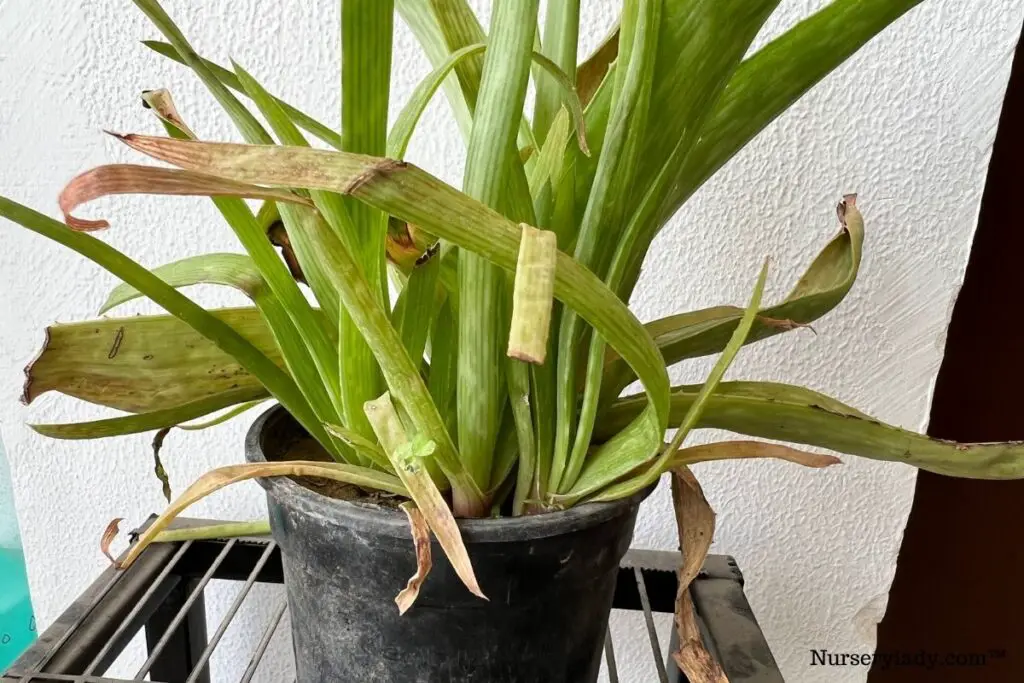
Aloe Vera grows better when they are root-bound.
But excessive root-bound is not good for any plant, even Aloe Veras.
Along with that, the Aloe Veras will also produce pups.
The roots and the pups together stay overcrowded in the container.
The pups fight for space, water, and nutrients in such conditions.
They completely drain the energy of the mother plant.
Both the mother plant and the babies will be tired, withered, and dry out due to a lack of space, water, and nutrients.
How to reduce overcrowding?
- When you find the pups are looking dry, check the condition of the plant. If they are overcrowded, repot the whole family to a bigger container.
- You can also remove the pups that have developed their roots. This will give the mother plant more space to spread the roots and new pups.
- While repotting, don’t remove the pups that are yet to develop new roots. Let them stay with the mother plant and repot them together.
- Water the babies after a few days. This will allow the roots to spread for water and take up water hungrily after a few days. It encourages fast growth. Keep the babies under filtered sunlight until the babies are well-established.
Also read: Does Aloe Vera Plant Like To Be Root Bound? (Possible Problems+Repot)
Pest infestation
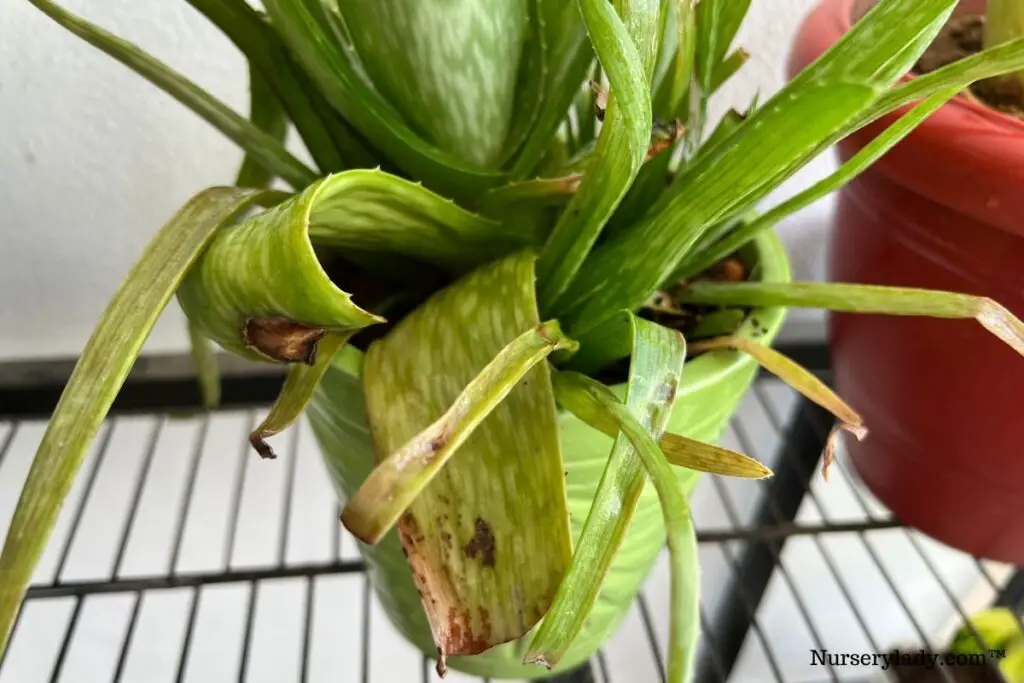
The bugs favor the lower leaves for staying.
When you find that the lower leaves are drying out, it is mostly because of pest infestation.
They suck all the saps of the plant and feed on them.
It will make the leaves discolored and distorted.
As they suck all the plant’s juices, prolonged infestation makes the leaves dry.
Common pests found in Aloe Vera plants are:
- Aphids
- Scales
- Mealybugs
- Spider mites
- Thrips
How to get rid of pests?
- Remove the extremely dried leaves from the plant. This will prevent further infestation and diseases.
- You can give a shower to your Aloe Vera plant with soap and garlic solution if you have detected the problem early.
- Spray neem oil to the infected area. It is safe and will kill all the pests from the plant.
- Dab some rubbing alcohol with a cotton ball on the infected area. It will weaken the hard-shelled bugs and kill them.
- Use insecticidal soaps like Safer soap.
- If the infestation is huge and all the above method fails, use chemical pesticides and insecticides. Read the instructions carefully before using.
Diseases
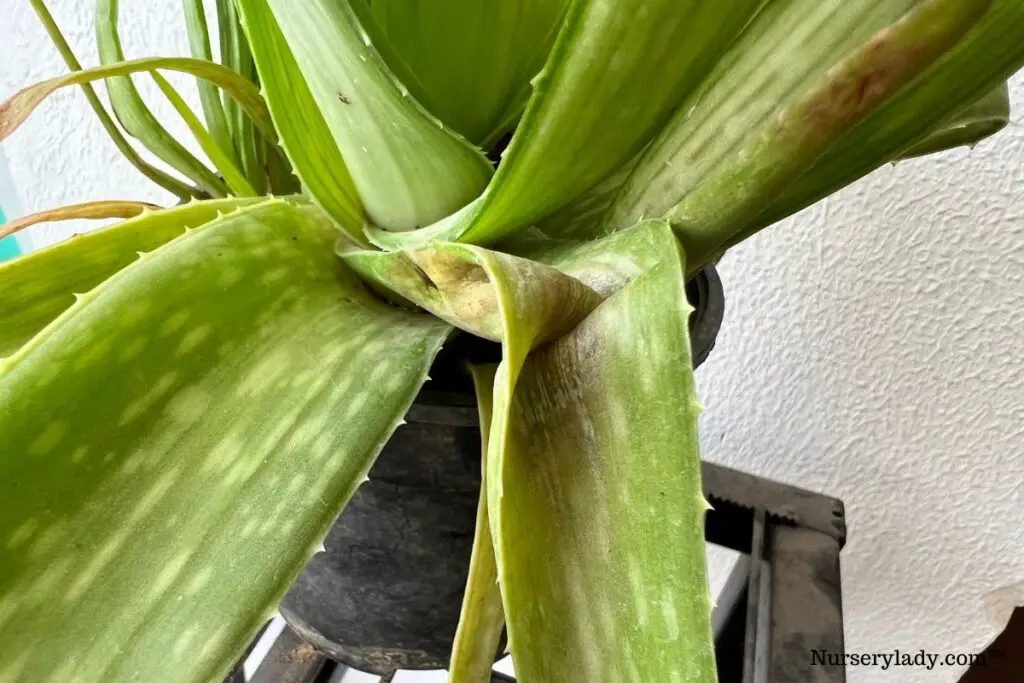
The common problem is root rot.
It happens when the soil stays waterlogged.
It not only suffocates the roots but also rots the roots and kills the plant.
Root rot damages the maximum portion of the roots, due to which the water fails to reach the plant, thus resulting in dried leaf tips.
The middle part of the leaves will be soft and mushy.
Another problem is dry rot. It is riskier than root rot.
This disease damages all the roots and the crown of the plant rapidly, within no time.
You can detect the problem by seeing dry leaves despite proper care and maintenance.
Dried leaves are the last sign of damage.
When the roots are infected, the plant cannot get enough nutrients and water.
Due to this, the leaves dry out and turn yellow.
How to treat the diseases?
- In the case of root rot, you have to take the plant out, remove the damaged roots and fully damaged leaves and replant it in a new location.
- If your plant is in the container, repot it with new soil. You can either use the same container or a new one. If you use the old one, wash it properly with bleaching powder or baking soda.
- Before transplanting it to a new location, add some charcoal to the cut portions. It will avoid further infections.
- Since dry rot is a soil-borne disease, check the soil quality. Use well-drained soil. If your plant is in the container, sterilize the soil before using it.
- Don’t stress them with overwatering. Keep the plant under filtered sunlight for some days until it recovers. Don’t bother them with fertilizing right now.
Low light

Low light generally doesn’t cause dryness in the plant.
Instead, it causes prolonged damp conditions and discolored leaves.
But low light will encourage pest infestation and diseases, thus resulting in dry Aloe Vera plant.
I have already mentioned before the consequences of bugs attack and diseases.
It leads to dry Aloe Vera plant.
How to address the issue?
- You should never keep the Aloe Veras in a fully shady or dim area. Always find a sunny location.
- Shift them to a sunny spot. Before planting outside, always find the right location for Aloe Veras, the one receiving sufficient sunlight.
- If the sunlight is harsh, fix shading nets. But never deprive the Aloes of light.
- If they are not getting enough sunlight indoors, use artificial lights that can provide 8000 foot-candles.
Also read: What Kind Of Light For Aloe Vera Plants? (Full sun, Shade, Or Partial Light?)
Will the Aloe Vera plant come back after drying up?
It depends on the amount of damage.
If few leaves have dried up, identify the right problem and fix it.
The partially-dried leaves can come back to normal health.
So don’t trim them off immediately.
Treat the issue and wait for some days to see their reaction.
The fully dried leaves will not come back.
So, you can remove them from the plant.
This will let the plant save energy to utilize it for new leaf growth and let the plant breathe.
But, if most of the leaves have dried up, wait until the plant recovers.
Don’t prune the leaves immediately after spotting the dry leaves.
Please wait for some days to see their condition.
Sometimes, freeze damage results in such conditions and even kills the plant.
It is better to take precautions so that the plant doesn’t have to face such situations.
Final thoughts
There are various reasons behind the Aloe Vera plant drying out. Most of the reasons will tell you that the problem mainly occurs due to negligence.
Indeed Aloe Veras can thrive in neglect, but they must be provided with their basic care needs so that they don’t encounter these problems.
Give them enough sunlight, water the Aloes once only when the top 2-3 inches are dry, don’t plant them in a completely open space outdoors, protect them from cold temperatures, and repot when they get overcrowded.
Drying during dormancy and heat in the summers is natural. Shift the plant to a mildly cool place to save them from heat.
Reference: NCBI, New York Botanical Garden, University of New Hampshire, University of Florida, Wikipedia.
